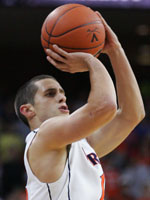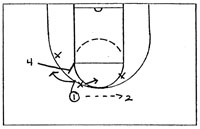 |
|
Sammy Zeglinski and UVa hope to take down Clemson. |
After hanging on for a tough 61-60 win at NC State, UVa returns home on Tuesday night for a battle with the Clemson Tigers, the Cavs’ third contest in six days. With a win over Brad Brownell’s squad, Tony Bennett’s Hoos (17-3, 4-2 ACC) would move three games above .500 in the ACC for the first time since February 2010, when a home win over NC State had the team at 5-2 in conference. Can the Cavs tame the Tigers?
The Clemson Primer gives us a closer look at the matchup.
1. Brad Brownell is in his second season at Clemson after successful stints at UNC Wilmington and Wright State. Last year, he led the Tigers to their first NCAA Tournament win since the Rick Barnes era but saw his team drop a 49-47 slobberknocker to the Hoos at JPJ. The team UVa faces this year won’t have last year’s dynamic duo of Demontez Stitt and Jerai Grant. Stitt, last year’s leading scorer and the top defender for the Tigers, is now bouncing around Europe while Grant, the second leading scorer, is now plying his trade in the land down under. Also gone are walk-on Zavier Anderson and Tennessee transfer Cory Stanton, who each averaged about 10 minutes per game.
Without Stitt and Grant, the Tigers have stumbled out of the gate to an 11-9 record and a 3-3 mark in the ACC. After winning their previous two ACC games at home over Georgia Tech (64-62) and Wake Forest (71-60) the last two Saturdays, Clemson stands at No. 104 in KenPom, No. 109 in TAPE, and No. 171 in RPI.
2. Brownell grew up in Evansville and started his coaching career serving under former University of Indiana player Jim Crews, so of course he worships at the altar of Bobby Knight. What this means offensively is that Brownell’s teams run a version of Knight’s motion offense, with plays usually starting out of a “3 out, 2 in” set. From there, the Tigers utilize a good number of down- and off-screens to create spacing and free 3-point shooters. In other words, this is Heartland offense that you would expect to see in the Midwest (or Durham).
Last year, playing against a squad with Stitt, Grant, and a No. 66 ranking in adjusted offensive efficiency, the Hoos held the Tigers to 47 points, the team’s second best defensive performance of the year (only allowed 44 against Radford). This year, Clemson is 100+ places lower in offensive efficiency (No. 170), meaning that points should be at a premium for the Tigers on Tuesday. So, what will Brownell do? The following PDF notes from a Brownell clinic show some of his ideas for playing against a sagging defense (somewhat comparable to the Pack-Line defense Virginia employs) and might provide a window into what we’ll see on Tuesday. This image shows flare screen action from those notes:
Some of these ideas, such as ball reversal and crosscourt passes, are what Cameron Dollar of Seattle has used successfully against Virginia the last two seasons, and it will be interesting to see what Tony Bennett has up his sleeve to counteract those actions if they appear.
3. On the defensive side of the ball, Brownell’s bread and butter is pressure man-to-man defense with a sprinkling of 2-3 and 1-3-1 zone. Before Sunday, I might have expected to see more zone on Tuesday, but after the Hoos’ 3-point shooters came alive against the Pack, I could see Brownell exclusively going man-to-man. Like NC State, Clemson is poor at defending the 3-ball, allowing opponents to hit 35.7% of their shots from behind the arc, which gives the Tigers a ranking of No. 231 nationally. Overall, though, they are a much better defensive team than the Wolfpack as Clemson comes into this game No. 54 nationally in adjusted defensive efficiency. Given UVa’s inability to score against Clemson last year, a short bench, and three games in six days, we might see Virginia’s offense struggle again.
4. Starting lineup:
PG: After playing off-the-ball most of last year, No. 11 Andre Young, a 5’9″, 170-pound senior, has become the primary ballhandler and scorer for this year’s Tigers. Young is averaging a team-high 13.9 points per game and doling out 3.4 assists per game against only 1.2 turnovers per game. Offensively, Young can fill it up from the free throw line (87.7%) and long range (36.3%). Defensively, Young is quick and tenacious, attributes that have allowed him to compile 1.9 steal per game as well as 3 rebounds per game. Last year, he actually corralled 5 boards against UVa to go along with a team-high 13 points. I’m really looking forward to seeing Young go at it with Jontel Evans , and I’m betting that Bub will be up for the occasion as well.
SG: Starting at the “2” for the Tigers will be No. 5 Tanner Smith, a 6’5″, 210-pound senior and the creator of Tanner’s Totes. Tanner, who played small forward primarily for the Tigers last year, is a very well rounded player. He has a nice handle for a player of his size and excellent court vision, which have led to him dishing a team-high 4.1 assists per game. His quick hands have led to 1.8 steals a game, and he uses his size to track down 5.5 rebounds per game. His shooting stats aren’t eye popping (44.7%, 36.5%, and 70% from the field, 3-point range, and the line), but he gets the job done to the tune of 11 points a game, second on the squad. Last year, he put up a goose egg against Virginia, and I think that Sammy Zeglinski and Malcolm Brogdon (who, like Smith is from Alpharetta, Georgia) will be able to contain him.
SF: No. 21 Bryan Narcisse, a 6’6″, 225-pound junior, has started the last two games for the Tigers (six overall) and averages 13.4 minutes per contest. Narcisse is probably known more for rocking Horace Grant goggles than anything else although he uses his 7’0″ wingspan to contribute solidly on the defensive end of the floor. On the offensive end, he’s not much a threat, averaging a mere 3 points per game on 42.3% shooting. Narcisse is sort of like Will Sherrill for UVa last year. He plays because he’s well versed in Brownell’s system and because there aren’t a lot of options behind him. I like Joe Harris ‘ chances to hit double figures on Tuesday against Narcisse and his smaller backups.
PF: Clemson’s starting power forward is No. 24 Milton Jennings , a 6’9″, 225-pound junior. Jennings’ game has stalled a bit this year in large part due to attitude problems that included him being suspended during the Diamond Head Classic for jawing off to Brownell. On the one hand, he’s scoring a shade more this year (8.9 PPG this year vs. 8.3 last year) on slightly better shooting from the field (44.1% vs. 41%). On the other, he’s averaging 2.5 turnovers per game vs. 1.9 last year and his free throw shooting percentage has dipped 19% (77.2% to 58.2%). Like the player he will face on Tuesday, Jennings is more of a face-up “4” who prefers to score via the mid-range jumper and is more fluid than explosive. Defensively, Jennings’ length allows him to disrupt his opponents’ shots when he puts in the effort at that end of the court. Last year, he had 9 points and 6 rebounds against a Hoos’ lineup that didn’t feature Mike Scott.
C: No. 31 Devin Booker, a 6’8″, 245-pound junior and the younger brother of Trevor Booker of the Washington Wizards. Booker is the most athletic player in the Tigers’ lineup and provides a quality defensive presence down low. Offensively, he has developed some decent post moves, but he’s not great at creating shots off of the dribble. Booker is third on the team with 10.6 points per game, and he leads the team with 6.8 rebounds per game. Last year, Booker had 7 points and 7 rebounds against the Cavaliers, and Akil Mitchell and Darion Atkins need to be focused on keeping Booker off the blocks as much as possible.
Key Bench Players:
Although certain Clemson players might make token appearances (Catalin Baciu, K.J. McDaniels, and former UVa recruit Bernard Sullivan average between 7.8 and 9.6 minutes per game), the Tigers are really seven deep, with only two bench players averaging 10+ minutes per game. Given the fact that both of these bench players are freshman guards, you can see why the Tigers are struggling this season.
PG: No. 4 Rod Hall, a 6’1″, 210-pound freshman, averages 20.3 minutes per game as a backup point guard. He doesn’t yet possess an ACC handle, and his shooting leaves something to be desired (43.4% from the field and 57.1% from the line). That said, he’s a tough, tenacious defender and a player who should end up giving the Tigers some quality minutes down the road.
SG: No. 1 T.J. Sapp, a 6’1″, 180-pound freshman, gets 19.4 minutes per game as an off guard. Sapp’s having a bit of a rough go of it as a freshman in the ACC. His defense is not quite up to par yet, and his shooting numbers are pretty poor across the board (34.7% from the field, 32.8% from 3, and 41.7% from the line). While Sapp averages 4.6 points per game, he’s only scored a total of 2 points in his last four ACC games.
5. Sabre Poster 504-C Brandon has the game as a 58.6-47.1 UVa win, with the Hoos having an 86% chance of winning. Meanwhile, the Team Rankings Simulation (available here) has it as a 56.9-52.8 Virginia win. Personally, I like UVa’s chances in this game, which should resemble a showdown between Bobby Knight’s Hoosiers and Dick Bennett’s Badgers circa 2000 as well as the game last year.
As noted above, the Tigers only have two posts that play more than 10 minutes a game, so they shouldn’t be able to bully the Hoos on the boards like NC State did on Saturday night. Indeed, the Tigers are only No. 116 in the country in adjusted offensive rebounding percentage. Last year, Clemson struggled to score against UVa even with Stitt and Grant, and without them, I don’t see the Tigers doing much better. Of course, the Cavaliers should struggle on that side of the ball as well, so I will call it a 53-46 Virginia win.
Author’s Note: Many of the statistics and analysis in this article were gathered through watching the two teams, ESPN.com, 504-C Brandon’s TAPE site, Warren Nolan RPI site, Teamrankings.com, and KenPom.com.




